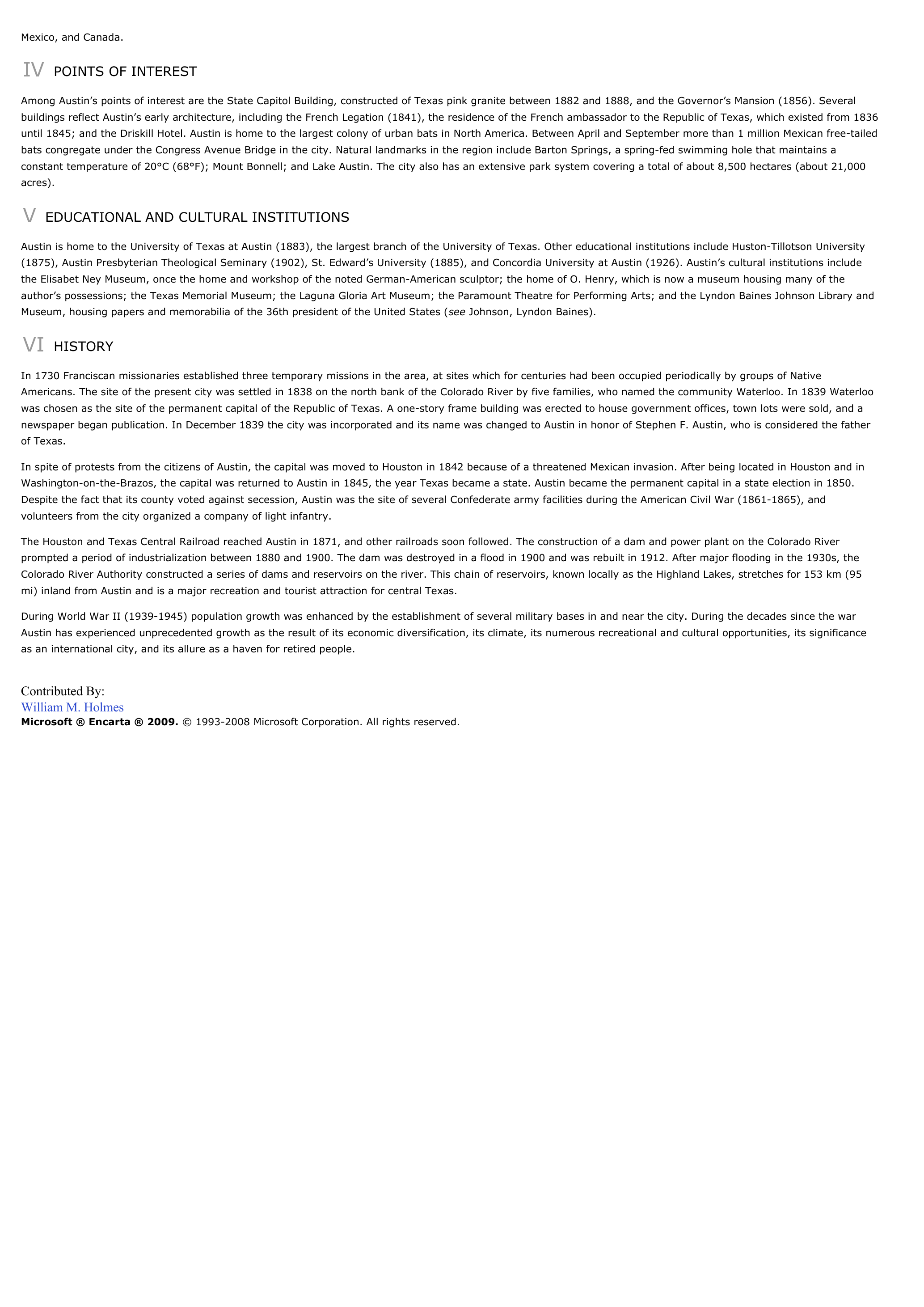Austin - geography.
Publié le 27/05/2013

Extrait du document
«
Mexico, and Canada.
IV POINTS OF INTEREST
Among Austin’s points of interest are the State Capitol Building, constructed of Texas pink granite between 1882 and 1888, and the Governor’s Mansion (1856).
Severalbuildings reflect Austin’s early architecture, including the French Legation (1841), the residence of the French ambassador to the Republic of Texas, which existed from 1836until 1845; and the Driskill Hotel.
Austin is home to the largest colony of urban bats in North America.
Between April and September more than 1 million Mexican free-tailedbats congregate under the Congress Avenue Bridge in the city.
Natural landmarks in the region include Barton Springs, a spring-fed swimming hole that maintains aconstant temperature of 20°C (68°F); Mount Bonnell; and Lake Austin.
The city also has an extensive park system covering a total of about 8,500 hectares (about 21,000acres).
V EDUCATIONAL AND CULTURAL INSTITUTIONS
Austin is home to the University of Texas at Austin (1883), the largest branch of the University of Texas.
Other educational institutions include Huston-Tillotson University(1875), Austin Presbyterian Theological Seminary (1902), St.
Edward’s University (1885), and Concordia University at Austin (1926).
Austin’s cultural institutions includethe Elisabet Ney Museum, once the home and workshop of the noted German-American sculptor; the home of O.
Henry, which is now a museum housing many of theauthor’s possessions; the Texas Memorial Museum; the Laguna Gloria Art Museum; the Paramount Theatre for Performing Arts; and the Lyndon Baines Johnson Library andMuseum, housing papers and memorabilia of the 36th president of the United States ( see Johnson, Lyndon Baines).
VI HISTORY
In 1730 Franciscan missionaries established three temporary missions in the area, at sites which for centuries had been occupied periodically by groups of NativeAmericans.
The site of the present city was settled in 1838 on the north bank of the Colorado River by five families, who named the community Waterloo.
In 1839 Waterloowas chosen as the site of the permanent capital of the Republic of Texas.
A one-story frame building was erected to house government offices, town lots were sold, and anewspaper began publication.
In December 1839 the city was incorporated and its name was changed to Austin in honor of Stephen F.
Austin, who is considered the fatherof Texas.
In spite of protests from the citizens of Austin, the capital was moved to Houston in 1842 because of a threatened Mexican invasion.
After being located in Houston and inWashington-on-the-Brazos, the capital was returned to Austin in 1845, the year Texas became a state.
Austin became the permanent capital in a state election in 1850.Despite the fact that its county voted against secession, Austin was the site of several Confederate army facilities during the American Civil War (1861-1865), andvolunteers from the city organized a company of light infantry.
The Houston and Texas Central Railroad reached Austin in 1871, and other railroads soon followed.
The construction of a dam and power plant on the Colorado Riverprompted a period of industrialization between 1880 and 1900.
The dam was destroyed in a flood in 1900 and was rebuilt in 1912.
After major flooding in the 1930s, theColorado River Authority constructed a series of dams and reservoirs on the river.
This chain of reservoirs, known locally as the Highland Lakes, stretches for 153 km (95mi) inland from Austin and is a major recreation and tourist attraction for central Texas.
During World War II (1939-1945) population growth was enhanced by the establishment of several military bases in and near the city.
During the decades since the warAustin has experienced unprecedented growth as the result of its economic diversification, its climate, its numerous recreational and cultural opportunities, its significanceas an international city, and its allure as a haven for retired people.
Contributed By:William M.
HolmesMicrosoft ® Encarta ® 2009. © 1993-2008 Microsoft Corporation.
All rights reserved..
»
↓↓↓ APERÇU DU DOCUMENT ↓↓↓
Liens utiles
- Austin - geography.
- QUAND DIRE, C’EST FAIRE, John Langshaw Austin
- FUITE EN AFRIQUE Austin Clarke (résumé)
- John langshaw Austin
- Une critique linguistique de la vérité-correspondance de J. L. AUSTIN

































